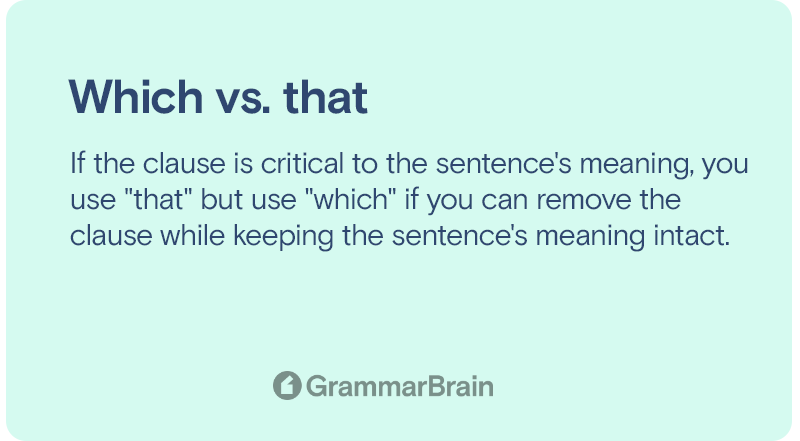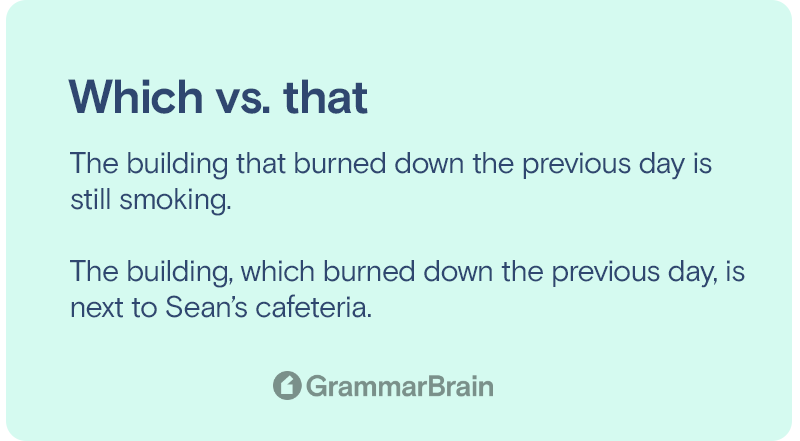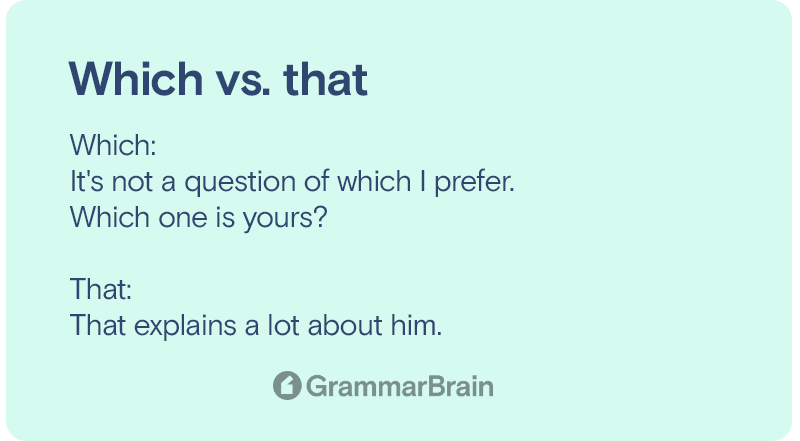What’s the difference between “which” and “that?” When should I use the word “that?” An when should I use the word “which?” These are great questions that will get answered in this comprehensive guide on English clauses.

What’s the difference between “which” vs. “that?”
The distinction between that and which is evident on the following grounds:
‘That’ is a pronoun used to identify something or someone who is not in close touch with the speaker. It can also be employed to add a clause to the main sentence to make it more meaningful.
On the other hand, “which” is an interrogative pronoun that may pose questions with restricted or fixed answers. It can also be used to insert a clause that provides information unrelated to the main sentence.
While ‘that’ can be used as a determiner, pronoun, or adverb, conjunction can only be used as a determiner and pronoun.
In terms of use, that is employed to establish a restrictive/essential clause. An essential clause offers some vital information about the sentence’s subject.
On the other hand, a non-restrictive/non-essential phrase is initiated by ‘which,’ i.e., it just adds supplemental or extraneous information.
We use ‘that’ to refer to persons and things, but ‘which’ solely refers to objects.

Understanding how to use “which” vs. “that”
The sentence after the word “which” or “that” is the deciding factor in selecting which word to employ.
If the clause is critical to the sentence’s meaning, you use “that” but use “which” if you can remove the clause while keeping the sentence’s meaning intact.
As an example:
- The building that burned down the previous day is still smoking.
- The building, which burned down the previous day, is next to Sean’s cafeteria.
The word “that burned down last week” is critical in the first line since it identifies the building that is still smoldering.
We might refer to any building without a clause, but we need to use the word “that” with an essential clause.
The word “which burned down last week” is superfluous in the second sentence because identifying the building is unnecessary. The statement would still make sense without it.
Therefore, it’s necessary to use the word “which” with a non-essential clause.
When to use “that”
It is necessary to grasp clauses to know when to utilize “that” or “which”.
A defining phrase (also known as an essential clause or a restricted clause) provides information necessary for the sentence’s meaning.
This is used to define clauses.
Here’s an example:
- My car that has a torn bumper is in the garage.
This statement implies that the speaker has at least one other car. The car he’s referring to is identifiable from his other cars by its shattered bumper.
If you omitted the phrase “that has a torn bumper,” you’d lose the hint that he owned more than one car. And even if you knew about his other cars, you’d have no idea which was in the garage.
Example sentences
- “To be yourself in a world that is constantly trying to make you something else is the greatest accomplishment.” -Ralph Waldo Emerson
- There were two additional baby birds that hadn’t fallen out.
- That’s a nice thing.
- That explains a lot about him.
- Do I really look that bad to you?
- That’s what you get for being so patient.
- That should be enough.
- What was the significance of that?
- That, I believe, is adequate.
- Perhaps that was the issue.
- Why would he do that thing?
- Did I ever tell you that you’re the funniest person I’ve ever met?
- That used to make me laugh.
- That’s why she doesn’t want him to be a part of it.
- It was the romance that had taken a hit.
- Don’t insult me like that, Steve.
When to use “which”
This includes non-defining clauses. Non-defining clauses (also known as non-restrictive or non-essential clauses) do not limit the phrase’s meaning in the same way that defining clauses do. If you delete the fascinating elements, the meaning of the text won’t alter.
Commas sometimes separate these sentences. Here’s an example:
- My car, which has a torn bumper, is in the garage.
The torn bumper is merely a description of the car in the garage in this case. There is no inference that the speaker has more than one car. Do you see the distinction?
Example sentences
- “By three methods we may learn wisdom: First, by reflection, which is noblest; Second, by imitation, which is easiest; and third by experience, which is the bitterest.” – Confucius
- Which is more significant to you, your car or me?
- It’s not a question of which I prefer.
- Which one is yours?
- You’ll need shoes now, but which ones?
- Which do you like better?
- Which is worse, an upset stomach or split lips?

How to remember which form to use
Perhaps an essential technique can assist you in remembering how to pick between that and which. Use “parenthesis” to comprehend the difference between that and which.
You can use ‘that’ if the sentence is completed with parentheses, but use ‘which’ if it is not.
FAQs
What is the rule for using which or that?
If the clause is critical to the sentence’s meaning, you use “that” but use “which” if you can remove the clause while keeping the sentence’s meaning intact.
Can you replace “that” with “which?”
“That” can get used to replace “which” without a comma. Using “that” without a comma is a strongly preferred grammar rule in American English (US).
Is “that” and “which” interchangeable?
Although they are both pronouns, the words “that” and “which are not interchangeable. “Which” is used for non-restrictive phrase and “that” is used for restrictive phrases.
Inside this article
Fact checked:
Content is rigorously reviewed by a team of qualified and experienced fact checkers. Fact checkers review articles for factual accuracy, relevance, and timeliness. Learn more.
Core lessons
Glossary
- Abstract Noun
- Accusative Case
- Anecdote
- Antonym
- Active Sentence
- Adverb
- Adjective
- Allegory
- Alliteration
- Adjective Clause
- Adjective Phrase
- Ampersand
- Anastrophe
- Adverbial Clause
- Appositive Phrase
- Clause
- Compound Adjective
- Complex Sentence
- Compound Words
- Compound Predicate
- Common Noun
- Comparative Adjective
- Comparative and Superlative
- Compound Noun
- Compound Subject
- Compound Sentence
- Copular Verb
- Collective Noun
- Colloquialism
- Conciseness
- Consonance
- Conditional
- Concrete Noun
- Conjunction
- Conjugation
- Conditional Sentence
- Comma Splice
- Correlative Conjunction
- Coordinating Conjunction
- Coordinate Adjective
- Cumulative Adjective
- Dative Case
- Determiner
- Declarative Sentence
- Declarative Statement
- Direct Object Pronoun
- Direct Object
- Diction
- Diphthong
- Dangling Modifier
- Demonstrative Pronoun
- Demonstrative Adjective
- Direct Characterization
- Definite Article
- Doublespeak
- False Dilemma Fallacy
- Future Perfect Progressive
- Future Simple
- Future Perfect Continuous
- Future Perfect
- First Conditional
- Irregular Adjective
- Irregular Verb
- Imperative Sentence
- Indefinite Article
- Intransitive Verb
- Introductory Phrase
- Indefinite Pronoun
- Indirect Characterization
- Interrogative Sentence
- Intensive Pronoun
- Inanimate Object
- Indefinite Tense
- Infinitive Phrase
- Interjection
- Intensifier
- Infinitive
- Indicative Mood
- Participle
- Parallelism
- Prepositional Phrase
- Past Simple Tense
- Past Continuous Tense
- Past Perfect Tense
- Past Progressive Tense
- Present Simple Tense
- Present Perfect Tense
- Personal Pronoun
- Personification
- Persuasive Writing
- Parallel Structure
- Phrasal Verb
- Predicate Adjective
- Predicate Nominative
- Phonetic Language
- Plural Noun
- Punctuation
- Punctuation Marks
- Preposition
- Preposition of Place
- Parts of Speech
- Possessive Adjective
- Possessive Determiner
- Possessive Case
- Possessive Noun
- Proper Adjective
- Proper Noun
- Present Participle
- Prefix
- Predicate



